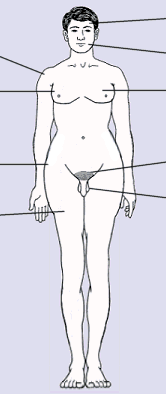|
Intersexuality - The Intersexual Spectrum
|
|
Causes of Intersexuality - Chromosomes
|
|
Males: Klinefelter Syndrome
|
|
The term “syndrome” refers to a variety of symptoms that have the same cause. In this case, the syndrome is named after the American physician Harry F. Klinefelter who was among the first to describe it in the 1940s. Not all possible symptoms are present in each case, but they do have the same cause: Instead of the typical chromosomal combination XY, there is an additional X-chromosome (XXY or, very rarely, XXXY). Some writers also include individuals with an XXX chromosonal combination in this group, and many of these do not see themselves as males, but as neuter or even females. The reason for the condition is some irregularity in the parents’ egg and/or sperm production, but how and why this happens is not yet fully understood. However: Many males with this atypical chromosomal combination do not develop a syndrome at all. In other words: They do not have any characteristic set of symptoms, but go through life without becoming aware of their extra X-chromosome. It is therefore somewhat questionable whether the term “Klinefelter syndrome” is really useful. It may be more accurate to speak simply of “XXY males”. As a rule, these males are infertile. They may have some language disability, and they may also have some or all the the physical features summarized in the following illustration:
Possible physical features related to Klinefelter syndrome
|
|
|
|
|
tallness
narrow shoulders
breast development
wide hips
long arms and legs
|
|
|
|

|
|
no frontal baldness
thin or absent beard
thin or absent chest hair
female pubic hair pattern
small testicles
|
|
|
|
|
|
|
|